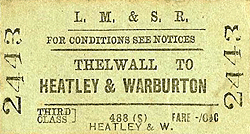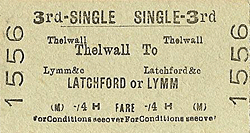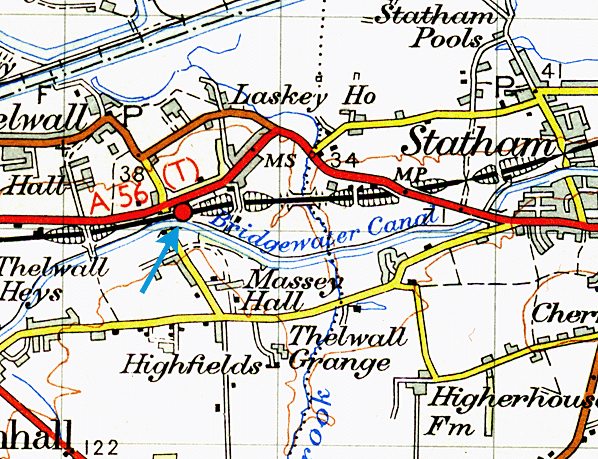Notes: Thelwall station was situated on the Warrington & Stockport Railway (W&S) which opened on 1 November 1853. The W&S route was authorised on 3 July 1851 as a line of the Warrington & Altrincham Railway (W&A) that would run to Warrington from a connection with the Manchester South Junction & Altrincham Railway (MSJAR) at Timperley Junction. At Warrington the W&A was authorised to make an end-on connection with the SHC&RC Garston and Warrington line and with the London & North Western Railway (LNWR) and the Birkenhead Joint Railway (BJR) at Walton Junction. On 4 August 1853 the W&A changed its name to the W&S.
Thelwall station opened with the line. It was located on the south side of the Warrington and Stockport Road (the present day A56) to the south-east of the settlement from which it took its name. Just to the south of the station was the Bridgewater canal.
The entrance to the station was located on the north side of the line and was via a gateway located on the main road. Set back from the road was a modest single-storey brick building with a pitched roof. The central door had large sash windows either side. Between the station building and the road there were three sidings that formed the station goods yard. Passengers had to cross the sidings to access the station.
Behind the station building was the up platform (Timperley direction). To the east of the building there was signalbox.
The down platform (Warrington direction) initially had only a simple waiting shelter. Passengers accessed the down platform by means of a barrow crossing.
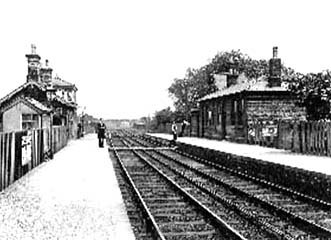 At the time of opening the W&S ran from a temporary station at Warrington Wilderspool to Broadheath. Broadheath was over a mile from Altrincham and was nowhere near Stockport . A comment made at the time was that the W&S went ‘from nowhere to nowhere’. It had not been the intention of the W&S to have an isolated line. The purpose of the W&S had been to create a route from Warrington to Manchester via the MSJAR railway. In doing so the SHC&RC would be able to reach Manchester from Garston and the BJR would have a link to the city from its network. The problem was that the MSJAR was under the joint ownership of the London & North Western Railway (LNWR) & the Manchester, Sheffield & Lincolnshire Railway (MS&LR). The LNWR was hostile to the idea of trains running between the BJR and the SHC&RC lines and Manchester as they saw this as creating routes to its own. For that reason the LNWR obstructed the W&S, putting it in a precarious financial position. At the time of opening the W&S ran from a temporary station at Warrington Wilderspool to Broadheath. Broadheath was over a mile from Altrincham and was nowhere near Stockport . A comment made at the time was that the W&S went ‘from nowhere to nowhere’. It had not been the intention of the W&S to have an isolated line. The purpose of the W&S had been to create a route from Warrington to Manchester via the MSJAR railway. In doing so the SHC&RC would be able to reach Manchester from Garston and the BJR would have a link to the city from its network. The problem was that the MSJAR was under the joint ownership of the London & North Western Railway (LNWR) & the Manchester, Sheffield & Lincolnshire Railway (MS&LR). The LNWR was hostile to the idea of trains running between the BJR and the SHC&RC lines and Manchester as they saw this as creating routes to its own. For that reason the LNWR obstructed the W&S, putting it in a precarious financial position.
A bridge over the Mersey was completed in the early months of 1854 and the W&S opened to Warrington Arpley on 1 May 1854. On the same day the line was also extended to Timperley Junction where it connected to the MSJAR.
Legal wrangling followed, and an arbitrator gave the W&S the right to run its trains over the MSJAR line to Manchester Oxford Road but at a financial cost that the W&S considered to be too high. The W&S had no choice but to pay, and their trains started to run between Warrington Arpley and Manchester Oxford Road on 31 October 1854.
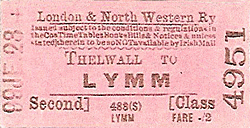 Things went from bad to worse for the W&S. Companies such as the BJR had obtained running rights over the line and the W&S had anticipated healthy receipts from them. The Great Western Railway (GWR) was a partner in the BJR and it intended to run services to Manchester via the W&S. In spring 1855 the line from Warrington Arpley to Walton Junction opened (the junction being just to the west of the station) making the GWR plan feasible. The problem was that the GWR and the LNWR were hostile to each other and the LNWR would not allow the GWR to use the MSJAR. The W&S had obtained an Act to build a line to Stockport at the time of its name change, but because of the turn of events it did not have the funds to proceed and the powers lapsed. The W&S company was never to reach Stockport. Things went from bad to worse for the W&S. Companies such as the BJR had obtained running rights over the line and the W&S had anticipated healthy receipts from them. The Great Western Railway (GWR) was a partner in the BJR and it intended to run services to Manchester via the W&S. In spring 1855 the line from Warrington Arpley to Walton Junction opened (the junction being just to the west of the station) making the GWR plan feasible. The problem was that the GWR and the LNWR were hostile to each other and the LNWR would not allow the GWR to use the MSJAR. The W&S had obtained an Act to build a line to Stockport at the time of its name change, but because of the turn of events it did not have the funds to proceed and the powers lapsed. The W&S company was never to reach Stockport.
In 1856 agreement was reached with the LNWR to extend some of the MSJAR trains to Warrington Arpley and effectively use the W&S as an extension of that line. The arrangement made for a better passenger service and one that delivered an operating surplus. Operation of the service which called at Thelwall began on 1 October 1856.
In 1857 the working relationship between the MS&LR and LNWR fractured and the companies became enemies. A railway war ensued and the MS&LR began to negotiate with the GWR. The MS&LR was now more than happy to allow the GWR to reach Manchester via the MSJAR line, which would have put the W&S on a more sound financial footing. The LNWR was quick to act, however, and it opened up negotiations with the GWR, agreeing in November 1858 to allow them to reach Manchester via LNWR lines.
The MS&LR began operating passenger services between Manchester and Garston, where an onward connection to Liverpool could be made by omnibus. They also introduced a service between Manchester and Chester. This was in direct competition with the LNWR and gave Thelwall perhaps the most diverse service it ever had.
For a brief period during the railway war the W&S line had taken on a role of importance just as its promotors had anticipated. During 1858 the SHC&RC and the MS&LR considered leasing the W&S but in autumn 1858 the railway war ended. It had cost all of the companies a great deal of money as they had cut fares and put on services in competition with each other. In November 1858 Thelwall lost the MS&LR services between Manchester and Garston/Chester.
To counter any future threats the LNWR took out a lease of the W&S on 13 August 1859 and absorbed it fully on 1 January 1861.
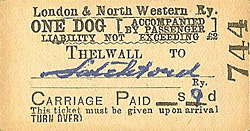 On 15 February 1864 a line was opened from Speke Junction (to the east of Garston) to Edge Hill (Liverpool) which allowed the LNWR to run trains from Thelwall direct to Liverpool. On 1 September 1864 the LNWR absorbed the SHC&RC. The LNWR operated mostly local trains from Latchford but it did use the line between Garston and Timperley Junction extensively for goods services. On 15 February 1864 a line was opened from Speke Junction (to the east of Garston) to Edge Hill (Liverpool) which allowed the LNWR to run trains from Thelwall direct to Liverpool. On 1 September 1864 the LNWR absorbed the SHC&RC. The LNWR operated mostly local trains from Latchford but it did use the line between Garston and Timperley Junction extensively for goods services.
On 1 December 1865 the former W&S was finally connected to Stockport when the Cheshire Lines Committee (CLC) opened a line from Broadheath (Deansgate Junction) to Stockport Tiviot Dale. The CLC was a joint railway of the MS&LR, the GNR and the Midland Railway (MR). The CLC had obtained running rights over the line between Garston and Broadheath, and they had taken over the Garston & Liverpool Railway (opened 1 May 1864) giving them a route between Stockport and Liverpool. One of the CLC partners was the MS&LR, so a route was also available between Manchester and Liverpool via Thelwall, and the CLC introduced passenger services onto the line.
Once again, however, the rivalry between companies had an impact on the former W&S line. The LNWR did all that it could to inconvenience the CLC trains. This resulted in the CLC building its own line between Garston and Manchester, with a branch to Stockport. The line opened in two stages on 1 August and 2 September 1873 and the former W&S route lost its CLC services.
Services settled down into a familiar pattern with passenger trains running between Liverpool Lime Street and Manchester London Road, with some shorter workings between Warrington and Manchester and some workings to Stockport.
The December 1895 timetable (shown below) showed 14 up services Monday-to-Friday with an extra train on Saturdays. Most of the trains ran to Manchester London Road. Although there was only 1 through train to Stockport there was a good connecting service for that place from Broadheath. In the down direction there were 15 trains Monday-to-Saturday. Eight of the down services went only as far as Warrington Bank Quay. On Sundays there were 3 trains in each direction.
| Up Trains December 1895 |
Destination |
Down Trains December 1895 |
Destination |
| 6.33am |
Manchester London Road |
8.09am |
Liverpool Lime Street |
| 7.33am |
Manchester London Road |
8.36pm |
Warrington Bank Quay |
| 8.09am |
Manchester London Road |
9.28am |
Liverpool Lime Street |
| 9.08am |
Manchester London Road |
9.58am |
Liverpool Lime Street |
| 10.00am |
Manchester London Road |
11.13am |
Liverpool Lime Street |
| 10.57am |
Manchester London Road |
1.15pm |
Warrington Bank Quay |
| 12.44pm |
Lymm |
1.41pm (Saturdays Only) |
Warrington Bank Quay |
| 1.25pm |
Manchester London Road |
2.09pm |
Warrington Bank Quay |
| 3.46pm |
Manchester London Road |
2.55pm |
Liverpool Lime Street |
| 4.20pm |
Manchester London Road |
4.18pm |
Warrington Bank Quay |
| 5.26pm |
Stockport |
5.37pm (Saturdays Excepted) |
Warrington Bank Quay |
| 6.23pm |
Manchester London Road |
6.03pm |
Ditton Junction |
| 7.16pm |
Manchester London Road |
6.45pm |
Warrington Bank Quay |
| 7.55pm (Saturdays Only) |
Lymm |
7.45pm |
Liverpool Lime Street |
| 9.21pm |
Manchester London Road |
9.37pm |
Liverpool Lime Street |
| |
|
11.23pm |
Warrington Bank Quay |
By the early 1900s the station facilities had been improved with the addition of a single-storey down platform building. It was larger and more attractive than the original building. Also built of brick, it had a hipped roof, arched door and window openings, and a paler coloured string course level with the base of the arched openings to add some interest.
By July 1922 Thelwall had an extra up service Monday-to-Friday and one less up service on Saturdays. In the down direction there was one less train Monday-to-Friday but on Saturdays the level of service was the same as 1895.
On 1 January 1923 Thelwall station became part of the London Midland & Scottish Railway (LMS). Their summer 1932 timetable showed 16 up and 15 down trains Monday-to-Saturday. Only 5 of the down trains went as far as Liverpool Lime Street Monday-to-Friday and 4 on Saturdays. On Sundays there were 2 trains in each direction.
During the Second World War passenger services were reduced to allow more freight trains and other war traffic to run. After the war the number of passenger services did not return to pre-war levels. The LMS timetable for the summer of 1947 showed only 9 trains in each direction Monday-to-Friday. On Saturdays there were 2 extra up and 1 extra down trains. No trains called at Thelwall on Sundays.
On 1 January 1948 Thelwall became part of British Railways [London Midland Region] (BR[LMR]). The BR[LMR] summer timetable for 1949 showed a similar level of service to that of the LMS in the year before nationalisation.
By 1953 there were still 9 trains each way Monday-to-Friday. On Saturdays there were retimed workings but still only 9 trains each way.
Thelwall was by this time an unremunerative station and in 1956 BR[LMR] gave notice that it was to close. The last trains ran on Saturday 15 September 1956 and the station closed completely on 17 September 1956.
Passenger services continued to pass through Thelwall after it had closed but on 10 September 1962 all local trains between Broadheath and Ditton Junction were withdrawn and the other intermediate stations were closed (with the exception of the Warrington Bank Quay low level platforms). A Liverpool to York train continued to pass through Thelwall until 17 July 1965 after which there were only diverted passenger services and freight.
The station remained intact for a number of years after closure but the down platform building had gone by the 1970s. The platforms had been demolished by 1980 but the original Warrington & Stockport building survived.
The line had been a very busy freight artery since LNWR times and during the 1960s and ‘70s it remained so. Even by 1985 there were 60 booked trains through Thelwall every week. However the need for expensive repair works at Latchford bridge resulted in British Rail closing it, the last trains running on 7 July 1985.
The line was lifted in 1988, and in the late 1990s its course through Thelwall was developed as part of the Trans-Pennine Way long distance path.
The original station building survived in industrial use until the 21st century, and after a brief period of dereliction it was refurbished as part of an office complex that was in use by 2012.
Tickets from Michael Stewart and route map by Alan Young
Sources:
- Encyclopaedia of British Railway Companies - Christopher Awdry - Guild Publishing 1990.
- The Manchester South Junction & Altrincham Railway - Frank Dixon - The Oakwood Press 1994.
- The Manchester South Junction & Altrincham Railway - Martain Bairstow - Published by Martin Bairstow 2014.
- The St Helens Railway, Its Rivals and Successors – J M Tolston – The Oakwood Press 1982.
To see stations on the Warrington and Stockport railway click on the station name: Warrington Arpley, Warrington Wilderspool, Latchford (1st),
Latchford (2nd), Lymm, Heatley &
Warburton, Dunham Massey & Broadheath.
See also the stations on the Garston and Warrington railway: Garston Dock,
Speke, Halebank, Ditton, Ditton Mill, Widnes (1st), Widnes South, Cuerdley, Fidlers
Ferry & Penketh, Sankey
Bridges &
Warrington
Bank Quay Low Level.
|

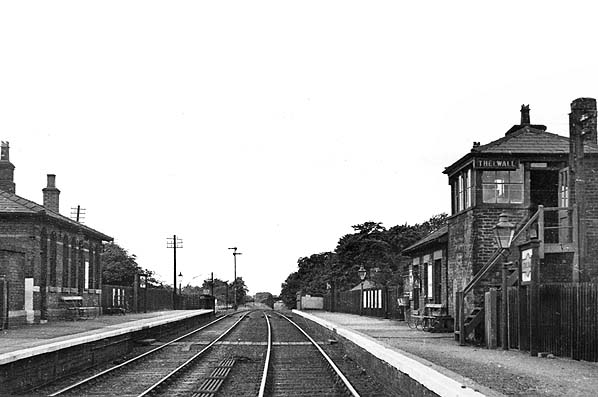
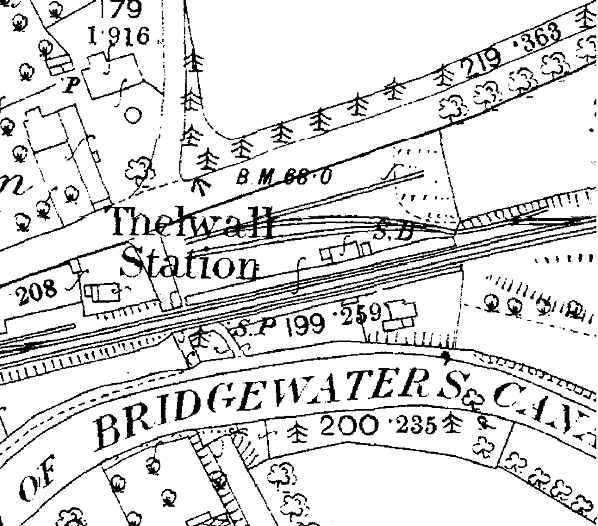
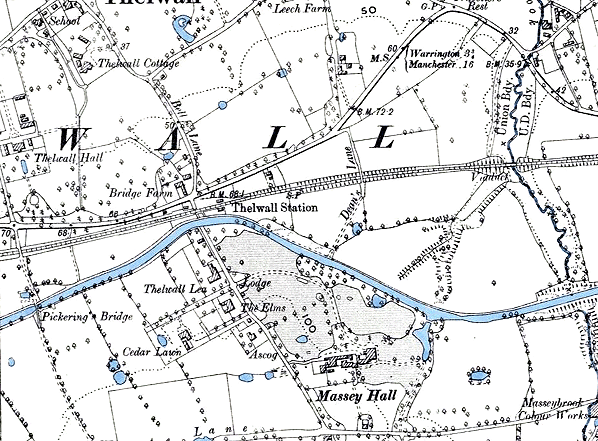
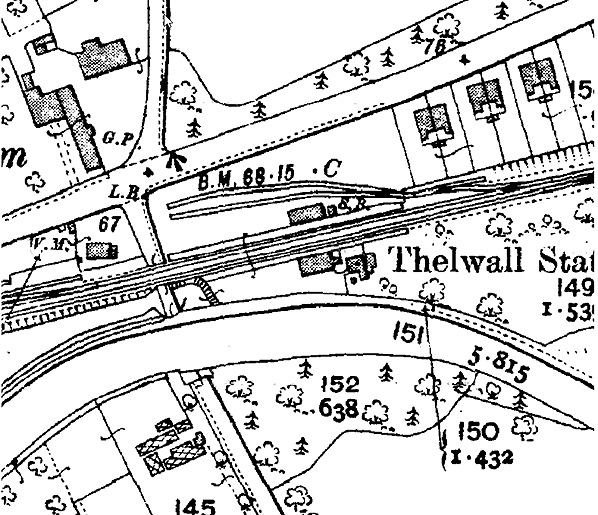
1.jpg)
2.jpg)
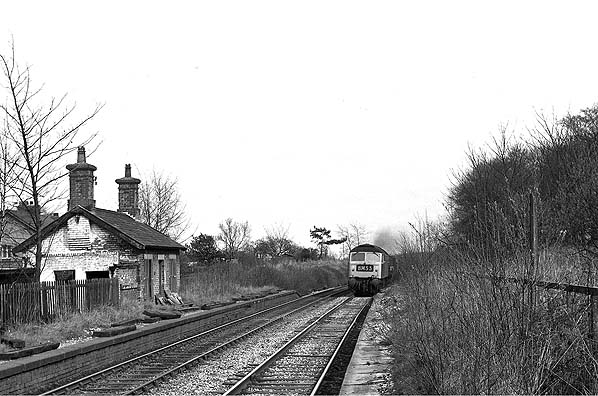
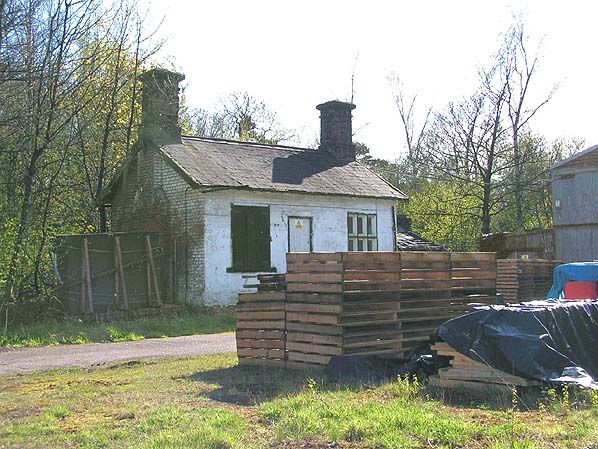
2.jpg)
 Home Page
Home Page 
 At the time of opening the W&S ran from a temporary station at Warrington Wilderspool to Broadheath. Broadheath was over a mile from Altrincham and was nowhere near Stockport . A comment made at the time was that the W&S went ‘from nowhere to nowhere’. It had not been the intention of the W&S to have an isolated line. The purpose of the W&S had been to create a route from Warrington to Manchester via the MSJAR railway. In doing so the SHC&RC would be able to reach Manchester from Garston and the BJR would have a link to the city from its network. The problem was that the MSJAR was under the joint ownership of the London & North Western Railway (LNWR) & the Manchester, Sheffield & Lincolnshire Railway (MS&LR). The LNWR was hostile to the idea of trains running between the BJR and the SHC&RC lines and Manchester as they saw this as creating routes to its own. For that reason the LNWR obstructed the W&S, putting it in a precarious financial position.
At the time of opening the W&S ran from a temporary station at Warrington Wilderspool to Broadheath. Broadheath was over a mile from Altrincham and was nowhere near Stockport . A comment made at the time was that the W&S went ‘from nowhere to nowhere’. It had not been the intention of the W&S to have an isolated line. The purpose of the W&S had been to create a route from Warrington to Manchester via the MSJAR railway. In doing so the SHC&RC would be able to reach Manchester from Garston and the BJR would have a link to the city from its network. The problem was that the MSJAR was under the joint ownership of the London & North Western Railway (LNWR) & the Manchester, Sheffield & Lincolnshire Railway (MS&LR). The LNWR was hostile to the idea of trains running between the BJR and the SHC&RC lines and Manchester as they saw this as creating routes to its own. For that reason the LNWR obstructed the W&S, putting it in a precarious financial position.  Things went from bad to worse for the W&S. Companies such as the BJR had obtained running rights over the line and the W&S had anticipated healthy receipts from them. The Great Western Railway (GWR) was a partner in the BJR and it intended to run services to Manchester via the W&S. In spring 1855 the line from Warrington Arpley to Walton Junction opened (the junction being just to the west of the station) making the GWR plan feasible. The problem was that the GWR and the LNWR were hostile to each other and the LNWR would not allow the GWR to use the MSJAR. The W&S had obtained an Act to build a line to Stockport at the time of its name change, but because of the turn of events it did not have the funds to proceed and the powers lapsed. The W&S company was never to reach Stockport.
Things went from bad to worse for the W&S. Companies such as the BJR had obtained running rights over the line and the W&S had anticipated healthy receipts from them. The Great Western Railway (GWR) was a partner in the BJR and it intended to run services to Manchester via the W&S. In spring 1855 the line from Warrington Arpley to Walton Junction opened (the junction being just to the west of the station) making the GWR plan feasible. The problem was that the GWR and the LNWR were hostile to each other and the LNWR would not allow the GWR to use the MSJAR. The W&S had obtained an Act to build a line to Stockport at the time of its name change, but because of the turn of events it did not have the funds to proceed and the powers lapsed. The W&S company was never to reach Stockport.  On 15 February 1864 a line was opened from Speke Junction (to the east of Garston) to Edge Hill (Liverpool) which allowed the LNWR to run trains from Thelwall direct to Liverpool. On 1 September 1864 the LNWR absorbed the SHC&RC. The LNWR operated mostly local trains from Latchford but it did use the line between Garston and Timperley Junction extensively for goods services.
On 15 February 1864 a line was opened from Speke Junction (to the east of Garston) to Edge Hill (Liverpool) which allowed the LNWR to run trains from Thelwall direct to Liverpool. On 1 September 1864 the LNWR absorbed the SHC&RC. The LNWR operated mostly local trains from Latchford but it did use the line between Garston and Timperley Junction extensively for goods services. 